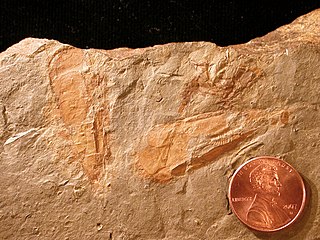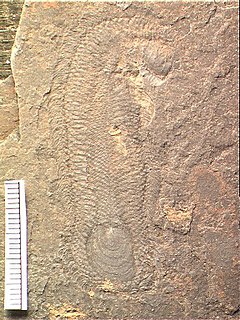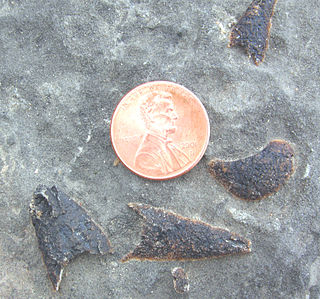
Hyoliths are animals with small conical shells, known as fossils from the Palaeozoic Era. They are lophophorates, a group which includes the brachiopods.

The halkieriids are a group of fossil organisms from the Lower to Middle Cambrian. Their eponymous genus is Halkieria, which has been found on almost every continent in Lower to Mid Cambrian deposits, forming a large component of the small shelly fossil assemblages. The best known species is Halkieria evangelista, from the North Greenland Sirius Passet Lagerstätte, in which complete specimens were collected on an expedition in 1989. The fossils were described by Simon Conway Morris and John Peel in a short paper in 1990 in the journal Nature. Later a more thorough description was undertaken in 1995 in the journal Philosophical Transactions of the Royal Society of London and wider evolutionary implications were posed.

Yochelcionella is an extinct genus of basal molluscs which lived during the Tommotian epoch, the first epoch of the Cambrian period. This genus is often reconstructed to resemble snails.
The Ellesmerocerida is an order of primitive cephalopods belonging to the subclass Nautiloidea with a widespread distribution that lived during the Late Cambrian and Ordovician.

The Helcionellids are small fossil shells that are universally interpreted as molluscs, though no sources spell out why this taxonomic interpretation is preferred. These animals are first found about 540 to 530 million years ago in the late Nemakit-Daldynian age, which is the earliest part of the Cambrian period. A single species persisted to the Early Ordovician. These fossils are component of the small shelly fossils (SSF) assemblages.
Hemithecella is a problematic genus of Ordovician mollusc proposed by Stinchcomb and Darrough in 1995. Hemithecella belongs to what are informally known as multiplated molluscs; it is found in the late Cambrian of the Ozarks and the Lower Ordovician of the same region as well as in Minnesota and the southern Appalachian Mountains. Hemithecella has muscle scars identical to a monoplacophoran and not the musculature of a chiton to which some authors have suggested the multiplated molluscs belong. It is therefore classified in the Mattheviidae.

Hypsibema missouriensis is a species of plant-eating dinosaur in the genus Hypsibema, and the state dinosaur of the U.S. state Missouri. One of the few official state dinosaurs, bones of the species were discovered in 1942, at what later became known as the Chronister Dinosaur Site near Glen Allen, Missouri. The remains of Hypsibema missouriensis at the site, which marked the first known discovery of dinosaur remains in Missouri, are the only ones to have ever been found. Although first thought to be a sauropod, later study determined that it was a hadrosaur, or "duck-billed" dinosaur, whose snouts bear likeness to ducks' bills. Some of the species' bones found at the Chronister Dinosaur Site are housed in Washington, D.C.'s Smithsonian Institution.
Hamptonia is a genus of sponge known from the Middle Cambrian Burgess Shale and the Lower Ordovician Fezouata formation. It was first described in 1920 by Charles Doolittle Walcott. 48 specimens of Hamptonia are known from the Greater Phyllopod bed, where they comprise < 0.1% of the community.
Stenothecoida is a taxon of bivalved fossils from the Early to middle Cambrian period. They look a bit like brachiopods or bivalve molluscs.
Allonnia is a genus of coeloscleritophoran known as complete scleritomes from the Middle Cambrian Burgess Shale. It is also a constituent of the small shelly fauna.
Paradycheia is a genus of polyplacophoran known from the Upper Cambrian Eminence Dolomite, Missouri, USA.
Dycheiidae is a wastebasket taxon containing problematic polyplacophora from Upper Cambrian strata in the USA.
Allochiton is a genus of upper Cambrian chitons with a circular head valve.
The Paleoloricata are valved polyplacophora without sutural laminae or insertion plates. The "order" probably represents a paraphyletic grouping.

Mattheviidae is an extinct taxonomic family of fossil chitons, marine polyplacophoran mollusks that are found in Upper Cambrian deposits.
Shelbyoceras is a genus of Cambrian monoplacophora which was one of the genera mistaken for a cephalopod, since the characteristics differentiating monoplacophora from cephalopods are few. Shelbyoceras was reclassified based on a depressed groove that forms a band around the shell, which is similar to a feature seen in Hypseloconus. The septa in this genus are either closely or irregularly spaced.
Polysacos is an extinct genus of multiplacophorans (chitons) known from articulated Carboniferous fossils; its seventeen shell plates are arranged in three rows, with seven iterated units. It demonstrates that multiplacophora are related to modern polyplacophora. It was fringed with a ring of hollow spines resembling those of the Ordovician Echinochiton.
Multiplacophora is a stem-group of chitons with a number of plates arranged in 7 rows along the body. They date to at least the Upper Cambrian, but two lower Cambrian fossils- Ocruranus and Trachyplax - may extend the range downwards.
Bruce Norman Runnegar is an Australian-born paleontologist and professor at UCLA. His research centers on using the fossil record to determine how, where, and when life originated and evolved. He has published on a wide variety of topics, including the phylogeny of molluscs, Dickinsonia fossils and oxygen levels, and molecular clock techniques.



